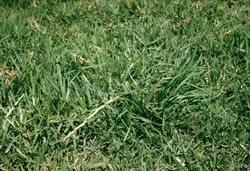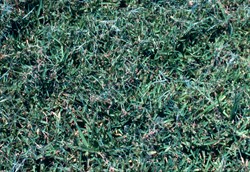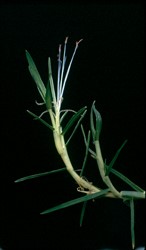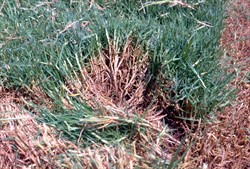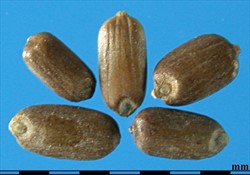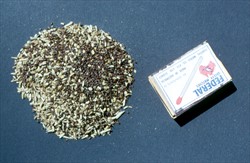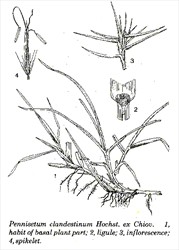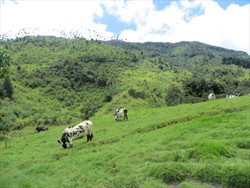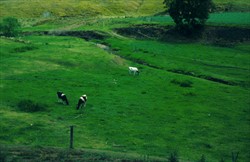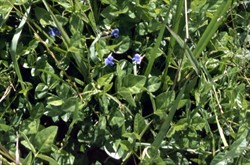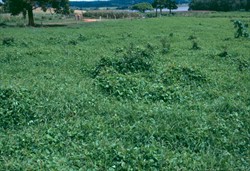Cenchrus clandestinus
Tropical Forages
Cenchrus clandestinus (Hochst. ex Chiov.) Morrone
Basionym: Pennisetum clandestinum Hochst. ex Chiov.; Kikuyuochloa clandestina (Hochst. ex Chiov.) H. Scholz
Family: Poaceae (alt. Gramineae) subfamily: Panicoideae tribe: Paniceae subtribe: Cenchrinae.
Stoloniferous and rhizomatous perennial, 30–40 (–70) cm tall, rhizomes slender, elongated, stolons much-branched and closely appressed to the ground, forming a turf under regular defoliation. Vegetative shoots with short stems and long leaves; vegetative shoots lower-growing than sterile shoots and with shorter leaves. Leaf sheath pale yellow-green, usually with fairly dense, fine tubercular-based hairs, sometimes glabrous; ligule a dense rim of hairs. Vegetative shoot leaf blade linear, 15–20 (–30) cm long and 2–5 (–8.5) mm wide, tightly folded when young, but opening flat when mature, glabrous or with sparse to dense tubercular-based hairs, finely serrated margins, apex acute to attenuate. Inflorescence reduced to a cluster of (1–) 2–4 (–6) very shortly stalked fertile spikelets, almost enclosed in the uppermost leaf sheath. Spikelets linear-lanceolate, 10–20 mm long, narrow, comprising 2 florets, the lower one sterile, the upper one bisexual or functionally male or female; 3 stamens, with anthers 5–7 mm long exserted on slender filaments to 50 mm long; single, occasionally bifid, white feathery stigma to 30 mm long. Caryopses ovoid, dark brown, about 2.5 mm long and 1.5 mm broad, pointed with persistent short style. Approx. 400,000 caryopses/kg.
Africa: chikoko, esereti, kigombe, lidadongo, olobobo (East Africa); umucaca (Kinyarwanda); kikoejoe, kikoejoegras, kikujugras, kikuyugras (Afrikaans); tajoe (Sotho)
Asia: ثيوم خفي (Arabic); 铺地狼尾草 pu di lang wei cao; xi fei lang wei cao (Chinese); ya-khikhuyu (Thai); kikuyu pul (Tamil, Sri Lanka), kikuyu tana (Sinhalese, Sri Lanka)
English: kikuyu grass, kikuyo grass, west African pennisetum (English)
Europe: mattosulkahirssi (Finnish); Kikuyugras (German)
Latin America: capim kikuyu, capim kikuyu, kikuiu, capim-quicuio (Portuguese); grama gruesa, kikuyo, pasto africano, tapete, zacate africano, zacate kikuyu, pasto de ciudad, pasto kikuyu, pasto Valencia, mijo perla, quicuyo, Sudán negro, cunde, andadora, hierba kikuyu, yerba kikuyu, kukuyú (Spanish)
Native:
Africa: Burundi; Democratic Republic of Congo; Eritrea; Ethiopia; Kenya; Malawi; Rwanda; Tanzania; Uganda; Zimbabwe
Naturalized/ Cultivated:
Africa: Algeria; Namibia; South Africa; Swaziland
Asia: Bhutan; China (Yunnan); Cyprus; India; Israel; Jordan; Taiwan
Australasia: Australia; New Zealand
Macaronesia: Madeira Islands; Canary Islands
Pacific Ocean: Easter Island; French Polynesia; Ecuador (Galapagos Islands); USA (Hawaii)
Northern America: USA (Arizona, California); Mexico (Chiapas, Chihuahua, Colima, Durango, Federal District, Hidalgo, Jalisco, Mexico, Michoacán, Morelos, Nuevo León, Puebla, Querétaro, San Luis Potosí, Tlaxcala, Veracruz)
Caribbean: Puerto Rico; Virgin Islands (St. John)
Central America: Costa Rica; Guatemala; Nicaragua; Panama
South America: Argentina; Bolivia; Brazil; Colombia; Paraguay; Peru; Uruguay; Venezuela
Indian Ocean: Mauritius; Réunion
Europe: Greece (Crete)
Forage
Kikuyu is mostly used as irrigated or dryland permanent pasture in the subtropics or upland tropics. In irrigated situations it can be used as the source of warm-season feed in conjunction with oversown ryegrass (Lolium spp.) for cool season feed. While it can be readily used for silage or wrap-bale haylage, opinion among farmers is divided on its suitability for hay making.
Environment
It can produce an excellent, stable ground cover to combat surface soil erosion. However, it has been observed kikuyu can create problems during floods where it is used for stabilising river banks, because the stable mat can actually encourage erosion if the eddying water undermines the sward.
Other
Lower-growing types have been adopted for turf, particularly for use in areas likely to be subjected to wear.
Soil requirements
Grows best on high fertility loam or clay soils, especially well-structured, red basalt-derived soils, but also on alluvial and fertilized moist sandy soils. Tolerates low pH (down to pH 4.5) and high Al and Mn, as well as moderate salinity. Prefers at least moderately drained soils.
Moisture
Kikuyu originates from areas with an annual rainfall of 1,000–1,600 mm. Although this native environment mostly does not have a pronounced dry season, the grass has become naturalized in areas of summer or winter rainfall with a distinct 5 month dry season. Where soils are suitable, it has become naturalized in areas with rainfall up to 3,000 mm and down to 800 mm/yr, and performing well under irrigation in lower rainfall areas. It is moderately drought tolerant, because of deep root system (to >3 m). Often found along water courses, it can tolerate some waterlogging and up to 10 days inundation. Most active growth occurs during periods of high humidity.
Temperature
In its native environment it largely occurs between about 8° N and S of the equator, and at altitudes from about 1,500 to 3,000 m asl. It has now become naturalized in the warm temperate, Mediterranean and lowland subtropical regions (25–38 °C) and to 3,800 m asl at 16° S in Bolivia, as well as in other tropical highland areas. In Hawaii (19–22° N), it extends from sea level to >2,000 m asl. Average annual temperatures over this distribution range from about (9–) 18 to 21 (–25) °C. The optimum temperature for growth is between 16 and 21 °C, with growth declining markedly at high temperatures and below 7 °C. In the lowland subtropics, this translates to best growth occurring in spring and autumn, moisture permitting, with depressed growth in the heat of summer and during winter. It is more frost tolerant than many warm season grasses, with only exposed foliage being damaged at about -2 °C. Although tops are killed, stands survive temperatures as low as -9 °C.
Light
Moderate shade tolerance but does not grow well in heavy shade.
Reproductive development
Can flower in any month in the absence of frost, with a peak in autumn and spring. Flowering is stimulated by regular mowing or heavy grazing. In bisexual spikelets, the stigma emerges 1–3 days before the stamens of the same flower, encouraging outcrossing.
Defoliation
Regular defoliation is necessary to maintain forage quality and palatability of the stand. Management should aim to maximise the amount of leaf, and minimise the amount of stem. Accordingly, stands should be grazed to about 5 cm in height and allowed to regrow to about 15 cm. If pasture height exceeds 15 cm, it is best to mow the sward back to 5 cm to remove stems and mature growth. If well fertilized, kikuyu is very tolerant of constant heavy grazing, although productivity is reduced under such management.
Fire
Rarely burnt but recovers from even severe fire by virtue of rhizomes. Some farmers traditionally burn heavily frosted, dried off kikuyu after winter to provide stock access to the fresh growth in spring.
Guidelines for establishment and management of sown forages.
Establishment
Kikuyu is readily established vegetatively or from seed. Harvested pieces of stolon or rhizome can be planted on a regular grid, or broadcast and cultivated into the soil surface. Subsequent rolling ensures better establishment. Seed is sown at 1–2 kg/ha when soil temperature reaches 20 °C. Good moisture conditions for several days after sowing are essential for effective establishment.
Fertilizer
Kikuyu is particularly demanding for N and P. While other nutrients are also essential, historically it has been decline in soil N and P levels that has led to decline in formerly productive stands. Renovation of “run-down” kikuyu grass should include incorporation of a legume or the use N and P fertilizer. Good production requires at least 150 kg/ha N applied in split dressings in spring and autumn, although linear responses to levels well above this have been obtained. Available soil P levels should be maintained at or above 15 ppm.
Compatibility (with other species)
Kikuyu is very competitive and generally incompatible with other grasses. Ryegrasses (Lolium spp.) can be oversown in autumn if the kikuyu is weakened by ploughing or with chemical prior to sowing. With the exception of Vigna parkeri, legume persistence is largely dependent on appropriate grazing management. Persistence of annual and more prostrate species depends on the sward’s being grazed heavily at some stage to facilitate redevelopment of the legume stand. Weeds tend to be a problem only in degrading forages.
Companion species
Grasses: Not planted with other grasses.
Legumes: Arachis pintoi, Lotus uliginosus, Trifolium repens, T. burchellianum, T. semipilosum, Vigna parkeri.
Pests and diseases
In Australia, kikuyu is attacked in summer by a soil-borne oomycete, Verrucalvus flavofaciens, causing ‘kikuyu yellows’ disease. This disease affects the roots and can devastate complete stands. A leaf-spot caused by Pyricularia penniseti causes a leafspot, death of leaf tips, and in severe cases death of seedlings – usually only in nutrient deficiency-weakened plants. Black spot (Bipolaris setariae) produces a characteristic black spot on the leaf and yellowing of the leaf tip, making the pasture less palatable to stock. Rust caused by (Phakopsora apoda) decreases photosynthetic capacity of infected leaves, but does not kill plants.
Various arthropods and their larvae cause temporary damage to stands. These include army worms (Spodoptera mauritia Lepidoptera: Noctuidae), tropical sod web worms(Herpetogramma licarsisalis, H. phaeopteralis Lepidoptera: Pyralidae), african black beetle (Heteronychus arator Coleoptera: Scarabaeidae), the pasture scarab beetle (Rhopea magnicornis), soldier fly (Inopus rubriceps Diptera: Stratiomyidae), the hunting billbug (Sphenophorus venatus vestitus Coleoptera: Curculionidae), kikuyu grass bug (Halticus chrysolepis Hemiptera: Miridae), the yellow sugarcane aphid (Sipha flava Homoptera: Aphididae), and mites (Tarsonemus sp.).
Ability to spread
On suitable soils, it can spread quickly from rhizomes and stolons, and from seed spread by cattle or water flow.
Weed potential
It largely presents a problem in soils of high fertility only, and can also be a problem in cooler areas where it can suppress growth of the more cool-season-productive C3 grasses. As a vigorous creeping grass, it can spread into cultivation areas or water channels where it can restrict flow. It has been declared a Federal Noxious Weed in the USA, and is considered at least "undesirable" in a number of countries.
Nutritive value
Well-fertilized kikuyu produces very high quality feed with over 25% CP and over 70% IVDMD in young leaf. CP levels tend to stay high for 1 or 2 weeks and then decline rapidly, to below 10% within 12 weeks. Digestibility also falls to <50% in the same period. Sodium levels (at 0.02–0.05% Na) can be deficient for lactating cattle, and calcium levels, although optimal for lactating cows, may be inadequate due to “tie-up” with oxalate. P levels change with season, falling as the species becomes dormant. A fall in P and a rise in Ca content results in a high Ca:P ratio (2.5:1) in spring. Optimum quality coincides with the 4½ leaf stage of regrowth.
For good silage fermentation, kikuyu needs to be wilted first or have extra sugar added because of its high moisture levels and low water soluble carbohydrate content.
Palatability/acceptability
Young growth is very soft and palatable, but older growth is not relished by most animals. The presence of a legume in the sward increases utilisation of the kikuyu.
Toxicity
Four nutritional problems are recognised in kikuyu – nitrate poisoning, bloat, oxalate poisoning, and kikuyu poisoning. Lush growth associated with excessive application of nitrogen can result in nitrate poisoning and even bloat, although the latter is rare. Hyperparathyroidism (‘big head’) in horses, and occasionally nephrosis or hypocalcaemia in ruminants, has been recorded due to high levels of oxalate (up to 1.1% DM). Kikuyu poisoning is a rare but serious problem. It occurs especially where rapid grass growth follows a protracted dry period, mainly in cattle (all classes and ages), but also in sheep and goats. Serious toxicity occurs spasmodically after rainfall in excess of 20 mm, grass temperatures above 14 °C and invasion of pasture by army-worms. The precise cause of kikuyu poisoning is not known. Symptoms include drooling of saliva, dehydration, abdominal pain, sham drinking, depression, incoordination, and recumbency, and in some cases distended abdomen, rumen stasis, elevated temperature and both cardiac and respiratory distress. Signs of toxicity appear within 1 to 8 days of cattle first grazing a toxic pasture, and once deaths start, animals may continue to die for another 1‒8 days, even if removed from the offending pasture.
Feedipedia link
Dry matter
DM yields are only limited by soil fertility and moisture availability. Under optimum conditions, it is capable of producing 30 t/ha/yr, but is unproductive if not fertilized. Responses in the order of 15–30 kg DM per kg N applied are reported.
Animal production
Well fertilized pastures are capable of carrying 1.5–3.0 adult cattle/ha. Dairy cows can produce over 15 L milk/hd/day, and beef animals over 400 kg/ha/yr LWG from vigorous kikuyu pastures. To maintain animal production in winter, kikuyu pastures can be oversown with temperate species (e.g. Lolium spp., Trifolium repens) following spraying with low concentrations of glyphosate (1–2 L/ha in 100 L/ha of water).
Tetraploid 2n = 4x = 36. Cultivars have largely been selected from natural variation. Studies into kikuyu genetics have identified options for variety improvement. particularly utilising the recessive male sterility gene. Differences in growth form, productivity, drought tolerance and salt tolerance have been identified.
The sward must be kept short to encourage flowering, seen as a ‘web’ of white stamens covering the sward. In the southern hemisphere, the seed crop is initially mowed off in October. Once flowering commences, it is mowed every 3 days, raising the cutting height by about 2 cm each time. After 2 months, the mowing interval is increased to 5 days. Once the crop has been frosted, the whole bulk is mowed to ground level and dried before threshing. Seed yields of 200–400 kg/ha are normal, and up to 700 kg/ha achievable.
Kikuyu is very susceptible to glyphosate, and can be severely set back by as low as 1 L/ha, and killed at 3 L/ha. It is also susceptible to haloxyfop-ethoxyethyl and imazapyr.
- Productive under heavy grazing.
- Good ground cover.
- Responsive to good fertility.
- Suited to subtropics and high altitude tropics.
- Requires fertile soils for persistence and production.
- Competitive against many legumes.
- Presence of rhizomes can favour weediness.
- Susceptible to ‘kikuyu yellows’ disease.
Bogdan, A.V. (1977) Tropical Pasture and Fodder Plants. Longman Inc., New York, USA. p. 222–229.
Bourke, C.A. (2007) A review of kikuyu grass (Pennisetum clandestinum) poisoning in cattle. Australian Veterinary Journal 85:261–267. doi.org/10.1111/j.1751-0813.2007.00168.x
Fraser, D., Sharp, P., Ahmad, N., Morris, B. and Trethowan, R. (2017) Abiotic stress tolerance of kikuyu (Cenchrus clandestinus) and some related grasses and potential of kikuyu for agricultural and urban environments. Crop and Pasture Science 68(3):285–296. doi.org/10.1071/CP15380
Gibbs Russell, G.E., Watson, L., Koekemoer, M., Smook, L., Barker, N.P., Anderson, H.M. and Dallwitz, M.J. (1990) Grasses of Southern Africa: An identification manual. Memoirs of the Botanical Survey of South Africa No. 58. Botanical Research Institute, Pretoria, South Africa.
Mears, P.T. (1992) Pennisetum clandestinum. In: Mannetje, L.’t and Jones, R.M. (eds) Plant Resources of South-East Asia No. 4. Forages. Pudoc Scientific Publishers, Wageningen, the Netherlands. p. 189. edepot.wur.nl/327785
Morris, B.W. (2009) Variation and breeding of kikuyu grass (Pennisetum clandestinum). Ph.D. Thesis. University of Sydney, Sydney, Australia. hdl.handle.net/2123/8961
Reeves, M., Fulkerson, W.J. and Kellaway, R.C. (1996) Forage quality of kikuyu (Pennisetum clandestinum): the effect of time of defoliation and nitrogen fertiliser application and in comparison with perennial ryegrass (Lolium perenne). Australian Journal of Agricultural Research 47:1349–1359. doi.org/10.1071/AR9961349
Ross, B.A. (1999) Pennisetum clandestinum in Australia. In: Loch, D.S. and Ferguson, J.E. (eds) Forage seed production, Volume 2: Tropical and subtropical species. CABI Publishing, Wallingford, Oxon, UK. p. 387–394.
'Acacia Plateau' PBR granted 2015. Open pollination followed by seedling selection: Seed parent Cenchrus clandestinus is characterised by an absence of male sterility and vigorous plant growth rate. Selection took place in "Yuma", Tamworth, NSW in 2010. Selection criteria: strong plant growth vigour, strong stolon growth, large leaf size, fertile, fast seedling emergence, strong branching.
'AZ-1' Released in Arizona, USA. A seed-producing sport from ‘Whittet’, developed in Arizona and selected for greater density and softer texture than common kikuyu or ‘Whittet’. It is mainly used as a turf, favoured for its winter colour retention, and lower vigour and lower invasiveness than common kikuyu or ‘Whittet’.
‘Breakwell’ Released in Australia (1971). Selected from a naturalized male fertile population at Grafton, NSW, possibly originating from Democratic Republic of the Congo. More densely tillered than ‘Whittet’, with more prostrate growth habit, narrower leaves, thinner stems and shorter internodes. Forms denser sward than that of ‘Whittet’. Between 15 and 20% of plants grown from seed are male sterile, but all are female fertile, producing good seed yields. Susceptible to ‘kikuku yellows’ disease.
‘Crofts’ Released in Australia (1983). Clonal selection from 34° S in NSW. Taller with more upright, narrower leaves and thinner, leafy shoots than ‘Whittet’ or naturalized kikuyu. Higher yields than ‘Whittet’ or naturalized kikuyu between 32 and 36° S, especially in cooler weather. Produces viable seed. Susceptible to ‘kikuku yellows’ disease.
‘Hosaka’ Released in Hawaii, USA (1982/3). Bred and released by Dr. Ukio Urata, University of Hawaii. Selected for higher yield, more open habit, improved drought tolerance and lower flowering intensity.
‘Kabete’ Released in Kenya (1938). Ecotype from Kabete, Kenya (1°16' S, 1,830 m asl, rainfall 1,000 mm). Intermediate morphology between ‘Molo’ and ‘Rongai’, with leaves of similar colour to those of ‘Molo’. The stamens are exserted, and functional pollen is produced.
‘Molo’ Released in Kenya. Ecotype from Molo, Kenya (0°15' S, 2,500 m asl). Finer stolons than ‘Rongai’ strain, with narrower, lighter green leaves. Less floriferous than ‘Kabete’ and ‘Rongai’. More productive than ‘Kabete’, but less tolerant of frequent defoliation under dry conditions than ‘Kabete’ and ‘Rongai’.
‘Noonan’ Released in Australia (1983). Single plant, ‘W2’, selected from seven single plants, at Grafton, New South Wales. These were chosen for further study from 200 plants grown from seed of open pollinated ‘Whittet’ and ‘Breakwell’ populations. Selected for ability to flower and set seed without stimulative clipping, a growth habit intermediate to ‘Whittet’ and ‘Breakwell’, higher dry matter yield during the cooler months, a good seed yield, and field tolerance to ‘kikuyu yellows’.
‘Rongai’ Released in Kenya. Ecotype from Rongai, Kenya (0°10' S, 1,910 m asl). Coarse with broad, dark green leaves and thick stolons; male sterile as anthers never exserted. More productive than ‘Kabete’.
‘Whittet’ (K53955, P 713) Australia (1970). Institutional collection from Kitale, Kenya, collected at 1,890 m asl. Taller growth, slightly broader leaves, thicker stems and longer internodes than naturalized type in Australia. Uniformly male fertile, producing good seed yields. Slower to form a dense sward than naturalized type. Susceptible to ‘kikuku yellows’ disease.
A considerable number of cultivars have been selected specifically for amenity purposes and are not included here.
None reported.
